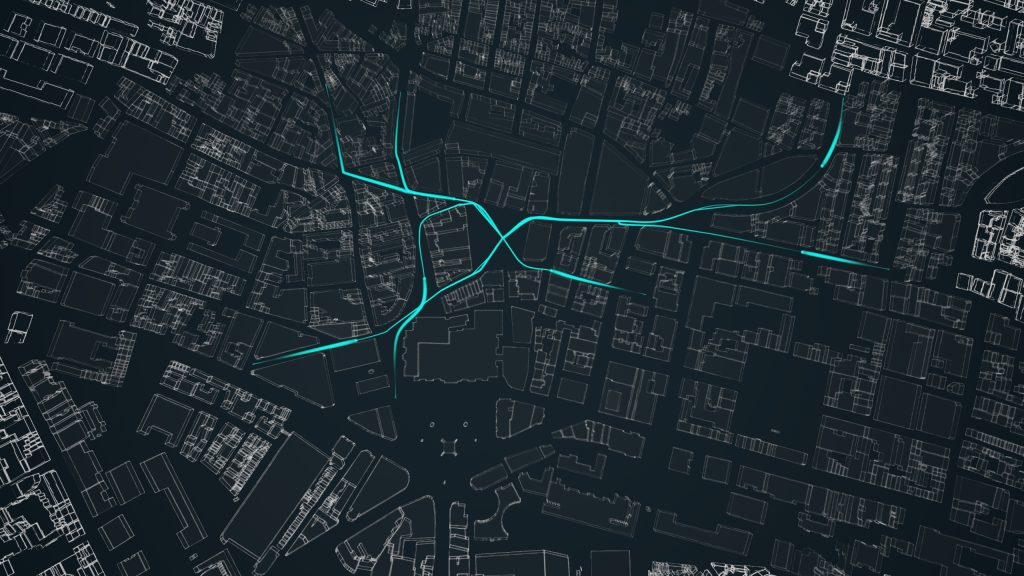
Zaha Hadid Virtual Reality Group presents at 2018 International Festival of Films on Art (Le FiFA) in Montreal
Created by the Zaha Hadid Virtual Reality Group (ZHVR Group) in collaboration with Google Arts & Culture, this virtual reality project engineered four of Hadid’s early paintings as virtual reality environments for the 2016 exhibition ‘Zaha Hadid: Early Paintings and Drawings’ at the Serpentine Sackler Gallery.
As a visionary architect and painter, Hadid changed the way we think about the relationship between mediums. These architectural painting proposals remain heroic unrealised projects, which makes the VR experience all the more poignant for its ability to show how their spatial qualities unfold. The four 360 degree films translate some of the key aspects and DNA contained inside the paintings, offering a dynamic and immersive experience of the works.
在蒙特利尔举办的2018年国际艺术电影节上,扎哈.哈迪德虚拟现实团队展示了他们一个神奇的项目。
这个虚拟现实项目由扎哈.哈迪德虚拟现实技术集团(ZHVR Group)与Google Arts&Culture合作完成,扎哈团队在2016年蛇形萨克勒美术馆“扎哈.哈迪德:早期绘画作品”画展上的陈列过一系列扎哈早期抽象画作品,其中的四幅便是这个虚拟现实项目的背景。
作为一位具有远见卓识的建筑师和画家,哈迪德改变了我们思考媒介之间联系的方式。 这些建筑绘画作品仍然是尚未实现的伟大项目,因而虚拟现实体验在展示它们空间品质的同时,能够给人留下深刻的印象。 这四部360度立体感官的电影阐释了绘画的一些关键层面和本质属性,提供了一个宛如身临其境的动态体验。

Google’s ultra-high resolution Art Camera documented the paintings to enable a close up and intimate relationship with the viewer. This immersive VR experience is also available online at Google Arts & Culture.
Helmut Kinzler, Senior Associate leading ZHA’s in-house virtual reality team, ZH VR Group, explained,“The VR painting installation was an idea that we pushed for – as a homage to Zaha, but also to promote the potential of our VR Group. The paintings done by Zaha in the 80s represent a level of experimentation and development of architectural ideas that were groundbreaking – but also remain as valid and as alive today.
谷歌的超高分辨率艺术相机将这些绘画作品都拍录下来,以便与参观者保持亲切紧密的联系。观众也可以通过Google Arts&Culture在线获得这种身临其境的虚拟现实体验。
扎哈.哈迪德虚拟现实技术集团内部的虚拟现实团队的高级副总裁Helmut Kinzler解释说,
“虚拟现实绘画装置是我们启动的一个概念项目——以此致敬扎哈.哈迪德,同时也是为了提升我们虚拟现实团队的潜力。扎哈在80年代完成的绘画作品代表了一个开创性的建筑理念实验和发展的水平,这些作品在今天依然具有时代效应,充满生机与活力。

“Virtual reality is a natural extension of the thinking behind the early paintings, which were influenced by Russian avant-garde artists including Kasimir Malevich. The paintings were the medium of choice for Zaha to break away from the ‘traditional’ architectural toolkit and to introduce a radical and innovative viewing, and to challenge the discourse.
“VR is the reciprocal digital platform today in which we want to show – and connect to – these ideas behind or inside the paintings. The paintings offer a highly individual reception and discourse between the designer and the viewer. In my view, Zaha made this choice to manifest that the ultimate benchmark and driver of architectural design is the individual.”
“这些早期绘画作品深深受到俄罗斯包括卡西米尔马列维奇在内的前卫艺术家的影响,虚拟现实是正是其背后思想的自然延续,。 这些画作是扎哈脱离“传统”建筑包袱,引入激进和创新理念,挑战时代话语的首选媒介。
“虚拟现实是我们如今搭建的互惠数字平台,旨在于这些绘画作品背后或内部将这些想法展示出来并联系起来。 这些绘画作品在设计师和参观者之间建立了非常独特的联系和对话。 在我看来,扎哈做出了这个选择,表明建筑设计的最终准则和驱动力是个体。“

Freya Murray, from Google Arts and Culture, believes Hadid’s use of perspective and space in her paintings pre-empted virtual reality,
“By taking the DNA of four of her paintings into virtual reality, our aim was to offer visitors to the exhibition new insights of the artworks and her architectural vision. It was a collaborative approach and one centred on continuing with Zaha Hadid’s legacy of experimentation. The first-person perspective inherent to immersive VR is the closest development of this thought and therefore the right medium to continue to explore.”
来自Google Arts and Culture的Freya Murray认为,哈迪德在绘画中运用的透视和空间手法是虚拟现实的预示。
“将扎哈四幅绘画作品的本质融入虚拟现实,我们的目标是为参观者提供展览中艺术作品和她建筑设想的新视野。这是一种合作方式,重点之一是继续探索扎哈哈迪德的实验理念。身临其境的虚拟现实技术所固有的第一人称视角是这一概念最新的发展成果,因而也是继续研究该技术的正确媒介。“

Image above: Still from the VR film of Zaha Hadid’s painting ‘The Great Utopia’ (a study for ‘The Great Utopia: The Russian and Soviet Avant-Garde’ exhibition at the Guggenheim Museum, New York). “We used the spiral to make a story, and the idea of moving seamlessly through the exhibition began to emerge, as if walking on a slope. We wanted to see how you could interrupt this movement with exhibits which pushed you to the edge of the ramp, giving views across the atrium to other works.” explained Zaha Hadid in 1992.
仍然来自扎哈.哈迪德绘画作品“伟大乌托邦”的虚拟现实电影(一项针对纽约古根海姆博物馆的“伟大的乌托邦:俄罗斯和苏联前卫艺术”展览的研究)。 “我们运用这个螺旋方式来创作一个故事,在展览中呈现一种无缝衔接的空间想法,就好像在斜坡上行走一样。我们希望看到参观者如何通过欣赏斜坡边缘的展品来打断这场运动,同时也能看到整个中庭的其他作品。“扎哈哈迪德于1992年解释道。




 下载手机APP
下载手机APP 关注微信公众号
关注微信公众号




















标题党就完事了
回复林航_: 林航???
所以。。。这和头号玩家的关系在哪
所以。。。这和头号玩家的关系在哪